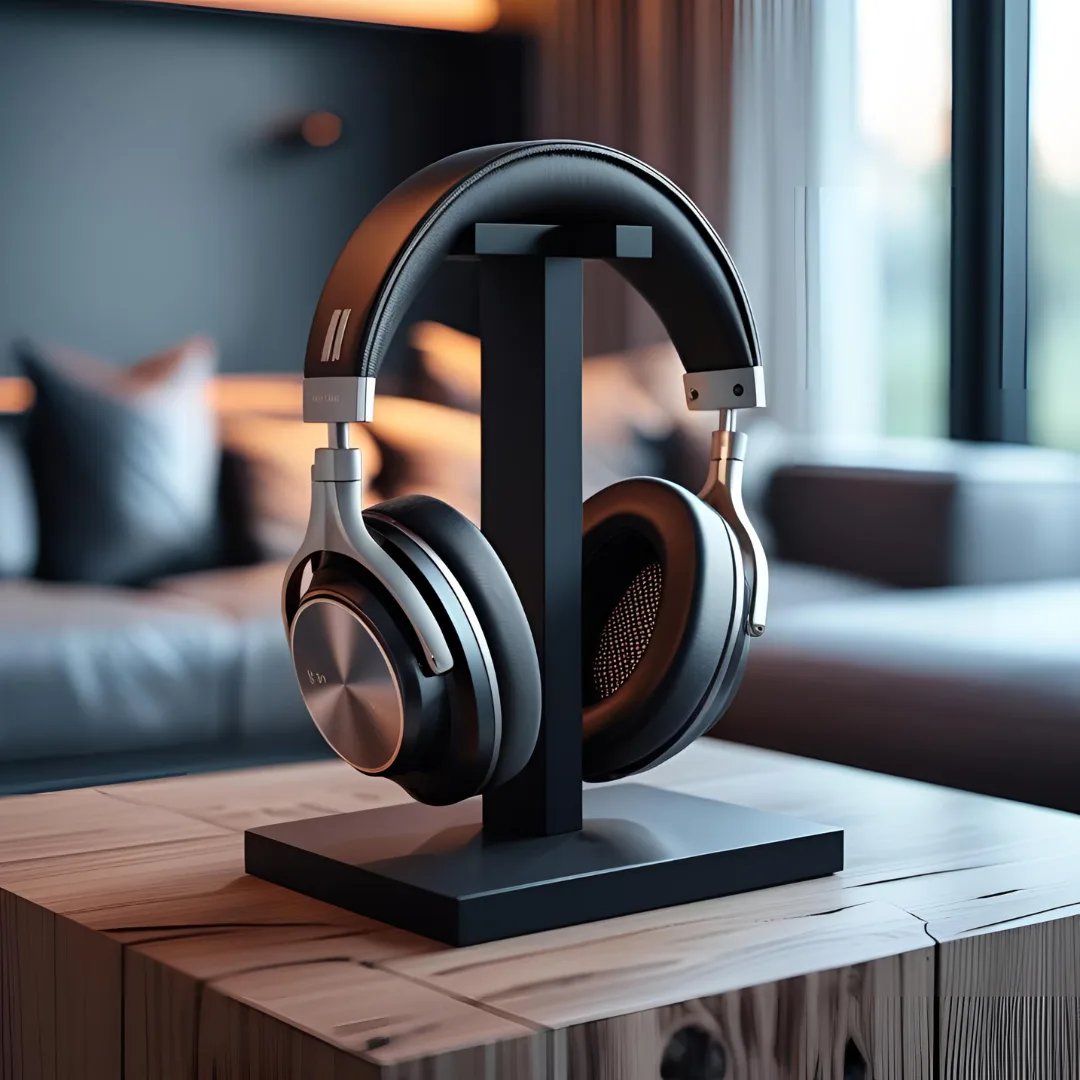
Affordable Hi-Fi Headphones
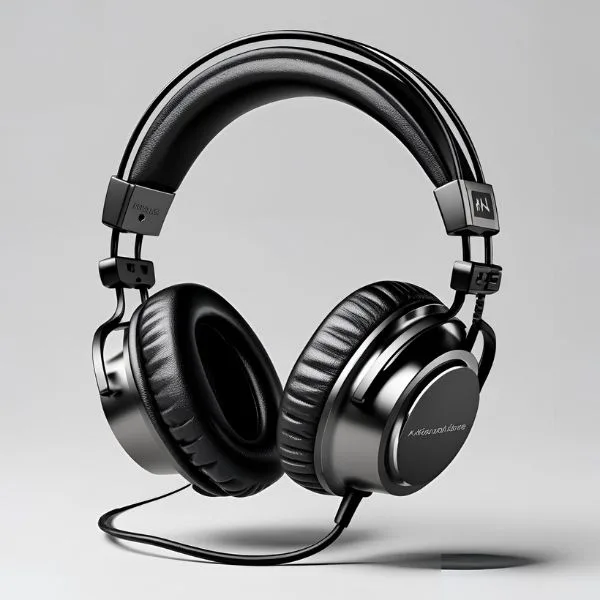
Have you ever heard the phrase, “high-fidelity audio costs a fortune”? This is a common perception that often excludes many music enthusiasts from a world of incredibly rich and detailed sound. The idea that only those who can spend thousands of dollars have access to a top-tier listening experience is a myth that needs debunking.
The good news is that in 2025, the headphone market is more vibrant and accessible than ever! There are amazing options that deliver a genuine audiophile experience for under $200. Yes, “audiophile bliss” can be perfectly affordable, and this guide is here to prove it.
In this article, we’ll dive into what truly defines an “audiophile” headphone, what to look for in this price range, and of course, our top recommendations for those seeking high-quality sound without breaking the bank. Get ready to rediscover your favorite music!
What Makes a Headphone “Audiophile” (Even on a Budget)?
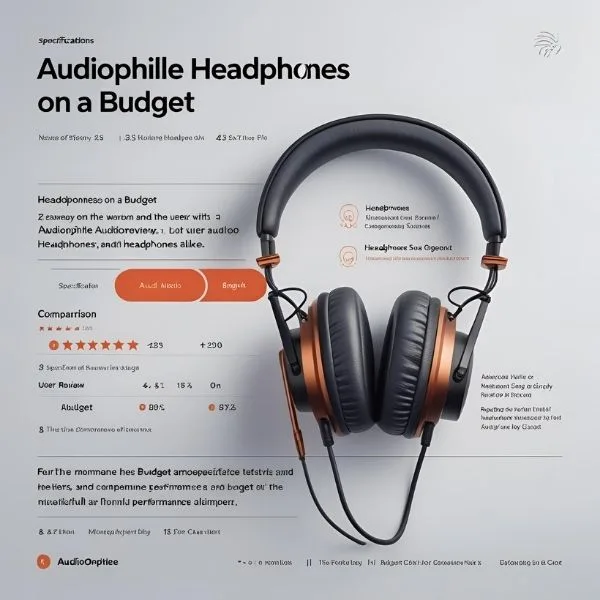
When we talk about “audiophile,” we aren’t necessarily talking about exorbitant prices, but rather a pursuit of sonic fidelity. Even on a limited budget, headphones can be considered audiophile if they excel in some key criteria:
- Clarity and Detail: The ability to hear every instrument, vocal, and nuance in the music with distinction, revealing textures and layers that ordinary headphones simply can’t reproduce.
- Soundstage: The perception of the dimension and space of the recording. It’s the sensation that instruments are positioned in different places around you, as if you’re in a concert hall or in the studio with the band.
- Imaging: The precision with which you can “locate” each instrument or vocal within that soundstage. You should be able to pinpoint where the sound of a violin or a drum hit is coming from.
- Balanced Frequency Response: Sound that doesn’t artificially overemphasize bass (making it “boomy”) or treble (making it “harsh”). The goal is a faithful and natural reproduction of the audio, as it was recorded.
- Comfort for Long Sessions: To truly appreciate high-fidelity music, you need headphones you can wear for hours on end without discomfort.
- Build Quality: Durable materials and thoughtful design that ensure your investment lasts for a long time.
Key Factors to Consider When Buying Under $200
To make the best choice in this price range, it’s important to consider some technical and practical aspects:
Headphone Type
- Over-Ear (Circumaural): These headphones completely enclose your ears. They generally offer the best comfort for long listening sessions and contribute to a better soundstage and immersion.
- On-Ear (Supra-aural): These rest on top of your ears. They’re more portable but can be less comfortable in the long run, as they apply direct pressure to the outer ear.
Headphone Design: Open-Back vs. Closed-Back

This is one of the most important decisions for a budget audiophile:
- Open-Back: These headphones have open or perforated earcups on the back.
- Pros: They offer a wider, more natural, and “airy” soundstage, with a sense that the sound is coming from a larger space. Ideal for critical and immersive listening.
- Cons: Sound leakage is high (people around you can hear what you’re listening to), and they offer little to no external noise isolation.
- Ideal for: Home use, in quiet environments, where you can fully concentrate on the music. For “audiophile bliss” within this budget, open-back headphones frequently offer a more expansive and natural sound experience.
- Closed-Back: The earcups are sealed, isolating the sound.
- Pros: They provide greater external noise isolation and prevent sound from leaking out, which is great for public use or recording (preventing headphone sound from bleeding into the microphone). Generally, bass is more impactful.
- Cons: The soundstage tends to be smaller and more “intimate,” and the sound might feel less “airy.”
- Ideal for: Use in noisy environments, public transport, or for monitoring during recordings.
Impedance
Impedance (measured in ohms) indicates the electrical resistance of the headphones:
- Low Impedance (below 50 ohms): Low-impedance headphones are easy to “drive” (reach sufficient volume) by low-power devices like smartphones and PCs, without the need for an external amplifier.
- High Impedance (above 50 ohms): High-impedance headphones generally demand more power to play at a satisfactory volume and reach their full sonic potential. They can significantly benefit from an external DAC/Amp (Digital-to-Analog Converter/Amplifier) to extract the best sound. Even in this sub-$200 price range, some good headphones might fall into this category.
Comfort and Build
- Comfort: Evaluate the earpad material (velour, synthetic leather), the clamping force (how tightly the headphones fit on your head), and the headband adjustment. A good audiophile headphone is one you forget you’re wearing, allowing for long listening sessions without fatigue.
- Build: Check the materials used (high-quality plastic, metal) and the assembly. A removable cable is a big plus, as it allows for easy replacement in case of damage, extending the headphone’s lifespan.
Top Audiophile Headphone Recommendations Under $200 (2025)
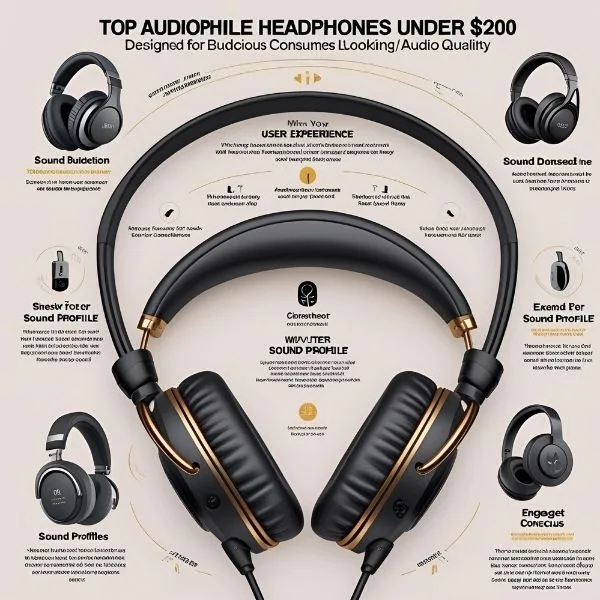
In 2025, the market offers some gems that deliver audiophile-level performance at a surprisingly affordable price. Here are our top recommendations:
- Sennheiser HD 599 SE (Open-Back, Over-Ear)
- Audiophile Strengths: Expansive and natural soundstage, excellent vocal clarity, detailed mids, present but well-controlled bass. Very relaxing and pleasant sound.
- Budget Pros: Offers much of the experience of higher-end Sennheisers for a fraction of the price. Exceptional comfort for long sessions.
- Considerations: Slightly “classic” design, doesn’t isolate noise.
- Best For: Classical music, jazz, vocals, casual and immersive home listening.
- Philips Fidelio X2HR (Open-Back, Over-Ear)
- Audiophile Strengths: Vast and cinematic soundstage, powerful and impactful bass, yet still with good definition. Fun and engaging sound.
- Budget Pros: Excellent build, comfortable velour earpads, great for gaming and movies due to its soundstage.
- Considerations: Bass can be a bit dominant for some, large design.
- Best For: Pop, rock, electronic, gaming, movies, engaging listening.
- Beyerdynamic DT 770 Pro (Closed-Back, Over-Ear) – 32 or 80 Ohms Versions
- Audiophile Strengths: Very fast and precise bass, detailed and “bright” treble, excellent noise isolation. Incredibly robust build.
- Budget Pros: An industry standard for studios, which speaks volumes about its sound quality and durability.
- Considerations: Treble can be “sibilant” for sensitive ears (especially the 250-ohm version, which usually requires an amplifier), initial comfort might feel tight.
- Best For: Studio monitoring, music production, DJing, listening in noisy environments, rock/metal.
- Koss KPH30i (Open-Back, On-Ear)
- Audiophile Strengths: Surprisingly wide soundstage for an on-ear, natural and engaging vocals, pleasant “vintage” sound signature. Extremely lightweight.
- Budget Pros: Unbeatable value for money (usually under $50!), sound that defies its price range.
- Considerations: More fragile (lightweight plastic build), comfort might be limited for some due to the on-ear design.
- Best For: Casual listening, portable use, vocals, for those seeking an analog and fun sound at a minimal price.
- Hifiman HE400se (Open-Back, Over-Ear) – Planar Magnetic
- Audiophile Strengths: Brings planar magnetic technology to an unprecedented price point. Fast and controlled bass, clean treble, excellent instrument separation, and soundstage. Incredible detail.
- Budget Pros: The most accessible entry point into the world of planar magnetics, a vast and detailed sound that rivals much more expensive headphones.
- Considerations: Generally requires an amplifier to extract its full potential (low impedance but demands current), robust but slightly heavy build.
- Best For: Beginner audiophiles, critical listening, instrumental music, rock, jazz, for those seeking planar precision.
- Audio-Technica ATH-M40x (Closed-Back, Over-Ear)
- Audiophile Strengths: Neutral and balanced sound, excellent for monitoring and mixing. Controlled bass and non-fatiguing treble.
- Budget Pros: Studio monitoring standard at an accessible price. Solid, foldable construction, ideal for transport.
- Considerations: Not as “fun” as headphones with more bass emphasis, comfort might be average for some during long sessions.
- Best For: Music production, audio monitoring, neutral and analytical listening.
Maximizing Your Audiophile Experience (Even on a Budget)
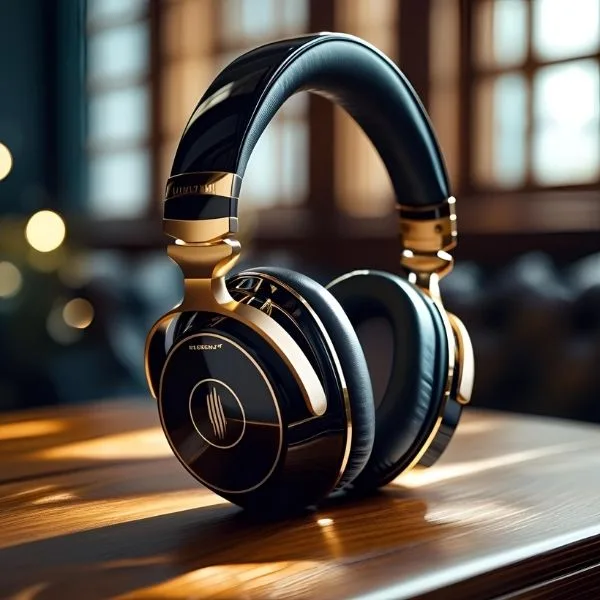
Buying an audiophile headphone under $200 is an excellent start, but a few habits and accessories can elevate your experience even further:
- Quality Audio Sources: Your headphones can only reproduce what they receive. Invest in high-quality audio files (FLAC, ALAC, WAV) or subscribe to Hi-Res streaming services (like Tidal, Qobuz, or Amazon Music HD). Avoid low-quality MP3s that “throw away” details.
- DAC/Amplifier (Optional, but Recommended for Some): A quality DAC (Digital-to-Analog Converter) converts the digital signal from your device into analog more faithfully. A headphone amplifier then amplifies that signal without introducing noise, giving your headphones “power.” For high-impedance headphones (like some versions of the DT 770 Pro) or planar magnetics (like the Hifiman HE400se), an affordable DAC/Amp (like USB DAC dongles from brands such as Tempotec, FiiO, or small desktop amps like the Fiio K3) can make a noticeable difference in dynamics, clarity, and volume.
- Listening Environment (For Open-Back): To truly appreciate the soundstage and details of open-back headphones, a quiet environment is crucial. Reduce distractions and external noise for total immersion.
- Headphone Care: Always store your headphones properly, avoid pulling on cables (especially if they aren’t removable), and consider replacing earpads periodically, as they affect both comfort and sound.
Conclusion: Your Journey to Superior Sound Begins Now
The idea that high-fidelity audio is an unattainable luxury is, fortunately, a thing of the past. In 2025, the headphone market offers a fantastic gateway to the audiophile world for under $200. With the right options, you can enjoy a level of clarity, detail, and immersion that was once reserved for much larger budgets.
This guide has shown that audiophile bliss is within everyone’s reach, even on a limited budget. We encourage you to explore the options, read detailed reviews (on Gear For Audio and other reliable sources), and if possible, try out some of these headphones. Don’t be afraid to dive into this high-fidelity universe; the reward is a new way to experience your favorite music.
Get ready to rediscover your favorite songs and hear details you didn’t even know existed. Which of these headphones has piqued your interest?
Further Resources: Your Affordable Audiophile Journey

Ready to dive deeper into the world of high-fidelity audio on a budget? Explore these additional resources to enhance your understanding and listening experience:
📚 Internal Links: More from Gear For Audio
- Open-Back and Closed-Back Headphones: Which is Right for You?
- Best DAC/Amps for Headphones: Unlock Your Audio’s Full Potential
- Headphone Drivers Explained: What You Need to Know for Optimal Sound
- Hi-Res Audio Gear 2025: The Ultimate Guide to High-Resolution Listening
- The 10 Best Noise-Cancelling Headphones of 2025
🔗 External Links: Expert Insights & Product Pages
- Sennheiser HD 599 SE: Explore the official product details for this popular open-back headphone: Sennheiser HD 599 SE
- Philips Fidelio X2HR: Learn more about the acclaimed Fidelio X2HR’s features and specifications: Philips Fidelio X2HR
- Beyerdynamic DT 770 Pro: Dive into the details of this studio-standard closed-back headphone, available in various impedances: Beyerdynamic DT 770 Pro
- Koss KPH30i: Discover the surprisingly audiophile-grade sound of these ultra-affordable on-ear headphones: Koss KPH30i
- Hifiman HE400se: Explore the entry point into planar magnetic headphones from Hifiman: Hifiman HE400se
- Audio-Technica ATH-M40x: Check out the specifications for this neutral, studio-grade closed-back headphone: Audio-Technica ATH-M40x
- What is Headphone Impedance? (Sennheiser Support): A clear explanation of headphone impedance and why it matters for your audio setup: Understand Impedance
- What is Soundstage and Imaging in Headphones? (Status Audio): A detailed breakdown of these crucial audiophile concepts: Learn Soundstage & Imaging
Frequently Asked Questions about Affordable Hi-Fi Headphones
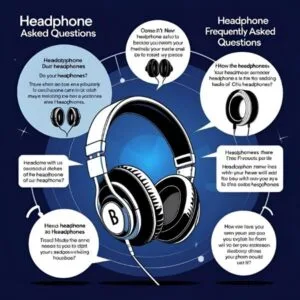
Here are some common questions about finding the best headphones under $200 that deliver a genuine high fidelity experience:
Q1: What exactly defines “Affordable Hi-Fi Headphones” or a “Budget Audiophile” experience?
A: “Affordable Hi-Fi Headphones” refers to headphones that deliver exceptional sound quality – characterized by clarity, detail, and a balanced frequency response – without costing a fortune. A “Budget Audiophile” experience means achieving a level of sonic fidelity typically associated with higher-end gear, but within a more accessible price range, often under $200. It’s about getting the best possible sound performance for your money.
Q2: Can I truly get “High Fidelity Headphones” for “Under $200”?
A: Absolutely! In 2025, advancements in audio technology and increased competition in the market have made it possible to find genuinely high fidelity headphones that offer impressive clarity, detail, and soundstage for under $200. While they might not match ultra-premium models, they provide a significantly elevated listening experience compared to standard consumer headphones.
Q3: What’s the difference between “Open Back vs Closed Back Headphones” and how does it affect sound and the “Headphone Soundstage”?
A: This is a crucial distinction for audiophiles:
- Open-Back Headphones: These have perforated or open earcups. They allow sound to pass in and out freely. This design typically creates a wider, more natural, and “airy” headphone soundstage, making it feel like the music is coming from a larger space around you. However, they offer poor noise isolation and leak sound.
- Closed-Back Headphones: These have sealed earcups. They provide excellent noise isolation, blocking out external sounds and preventing your audio from leaking out. Their headphone soundstage tends to be more intimate and direct, with a more impactful bass response, but can sometimes feel less “airy” than open-backs.
The choice depends on your listening environment and preference for soundstage and isolation.
Q4: What is “Headphone Soundstage” and why is it important for an audiophile experience?
A: “Headphone Soundstage” refers to the perceived spatial dimension and arrangement of the audio. It’s the illusion that instruments and vocals are positioned at different points in space (width, depth, and even height) around you, rather than just being confined to your head. For an audiophile experience, a good soundstage creates a more immersive and realistic listening environment, allowing you to “place” each element within the mix, much like you would at a live performance.
Q5: What are the key features to look for when buying the “Best Headphones Under $200” for a “Budget Audiophile”?
A: When seeking the best headphones under $200 for a budget audiophile experience, prioritize:
- Clarity & Detail: The ability to discern individual instruments and nuances.
- Balanced Frequency Response: Natural sound without excessive bass or harsh treble.
- Soundstage & Imaging: A sense of space and precise instrument placement.
- Comfort: Essential for long listening sessions.
- Build Quality: Durable materials for longevity.
- Headphone Type (Open-Back/Closed-Back): Choose based on your environment (quiet home for open-back, noisy commute for closed-back).
- Impedance: Consider if your source device can adequately drive the headphones, or if a separate amplifier is needed.


Pingback: The 10 Best Noise-Cancelling Headphones Of 2025: Your Guide To Silent Serenity
Pingback: Top 7 Wireless Earbuds For Every Budget: Find Your Perfect Pair
Pingback: Best USB Microphones For Streaming And Podcasting In 2025
Pingback: Top 10 Essential Audio Accessories For Music Lovers In 2025
Pingback: Best Audio Accessories 2025 – Buyer’s Guide To Upgrade Your Setup
Pingback: Unlock Incredible Sound: Must-Have Audio Accessories For Serious Audiophiles In 2025
Pingback: What's The Difference Between Open-Back And Closed-Back Headphones?
Pingback: Top 5 Hearing Protection Accessories For Musicians & Concert-Goers (2025 Guide)